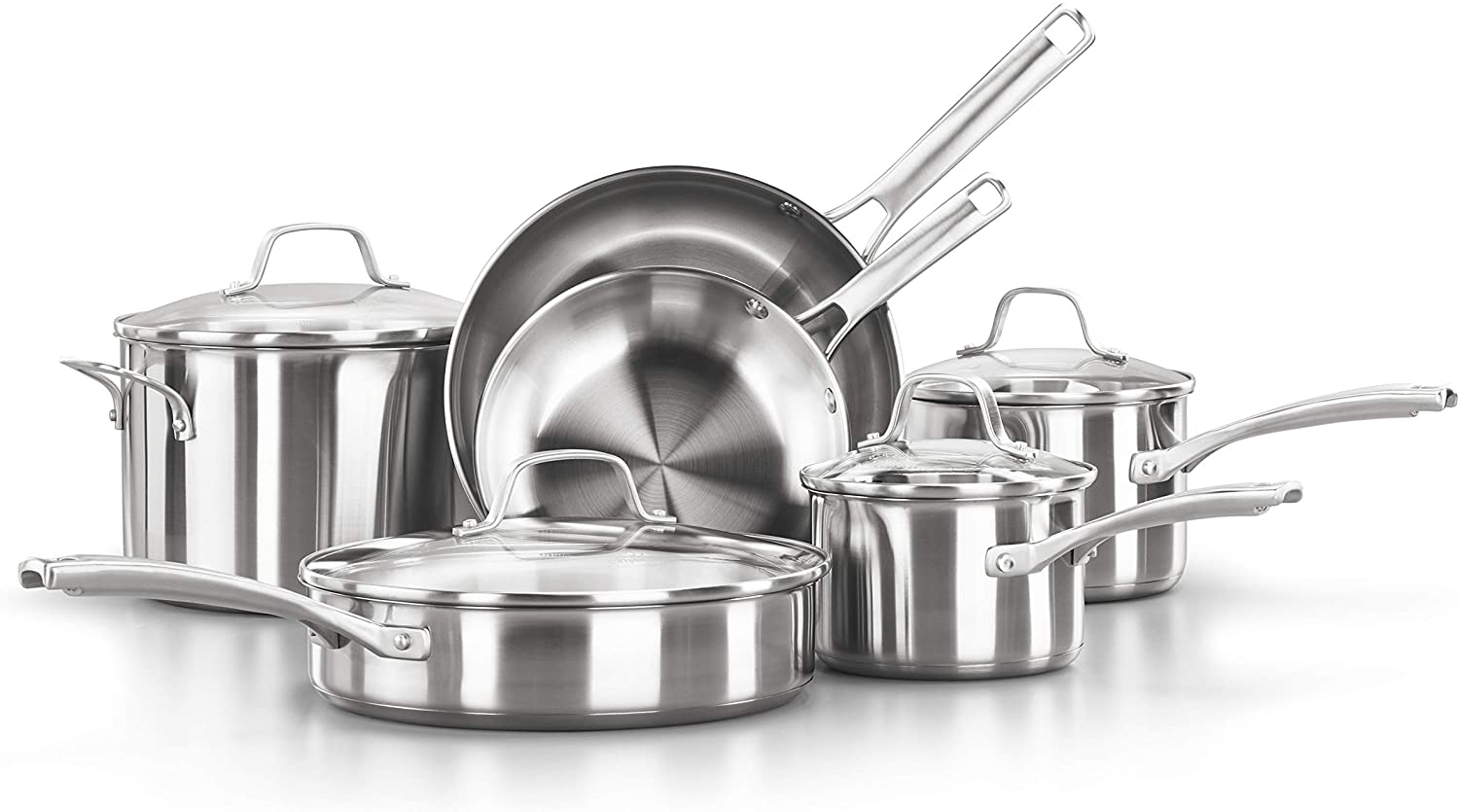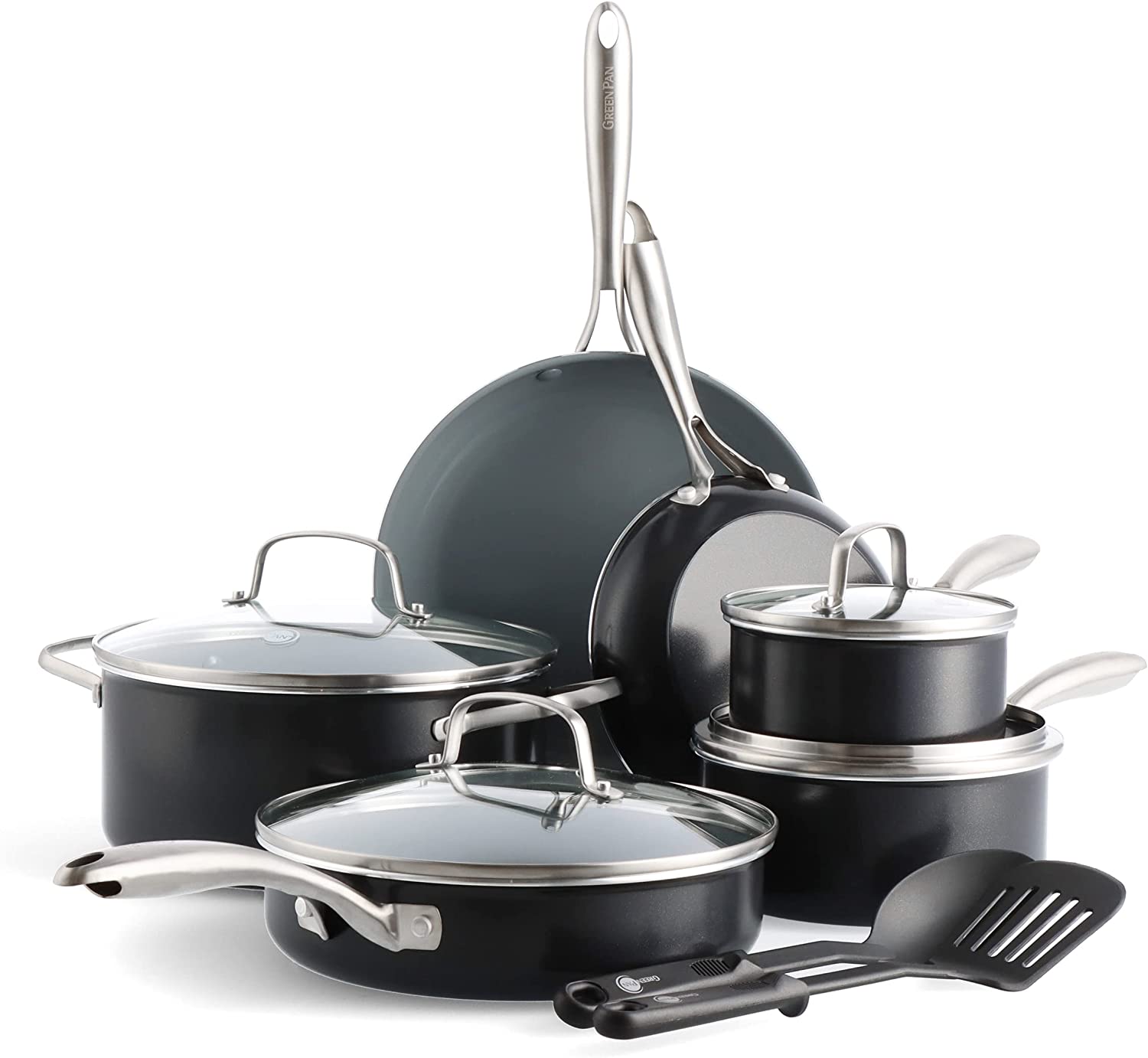When it’s time to get a replacement pan or maybe even a new 9-piece cookware set to deck out your new kitchen, you’ll be faced with a wide range of options to choose from. If you’re lucky enough to have a gas stove, you’ll also want to pick a pan that lets you utilize the high heat of your gas cooking stove. Here is a run down of the Best Pots and Pans for Gas Stoves.
Luckily with gas cooking stoves, you’ll be able to use any type of cookware with it, unlike induction cooktops which require pots and pans made out of ferrous metals. All these options listed will also work for an electric stove, if that’s what you have at home.
Our Top Picks
Considerations When Cooking Over a Gas Flame
Cooking over a flame has some inherent benefits that other cook-top heat sources don’t provide. The ability to turn change the heat level instantly is probably the most famous benefit of cooking with a gas flame. Simply by turning the knob of the regulator you can minutely adjust the heat for anything. Another benefit is you can visually see the flames, so you know almost exactly how much heat is hitting the pan.
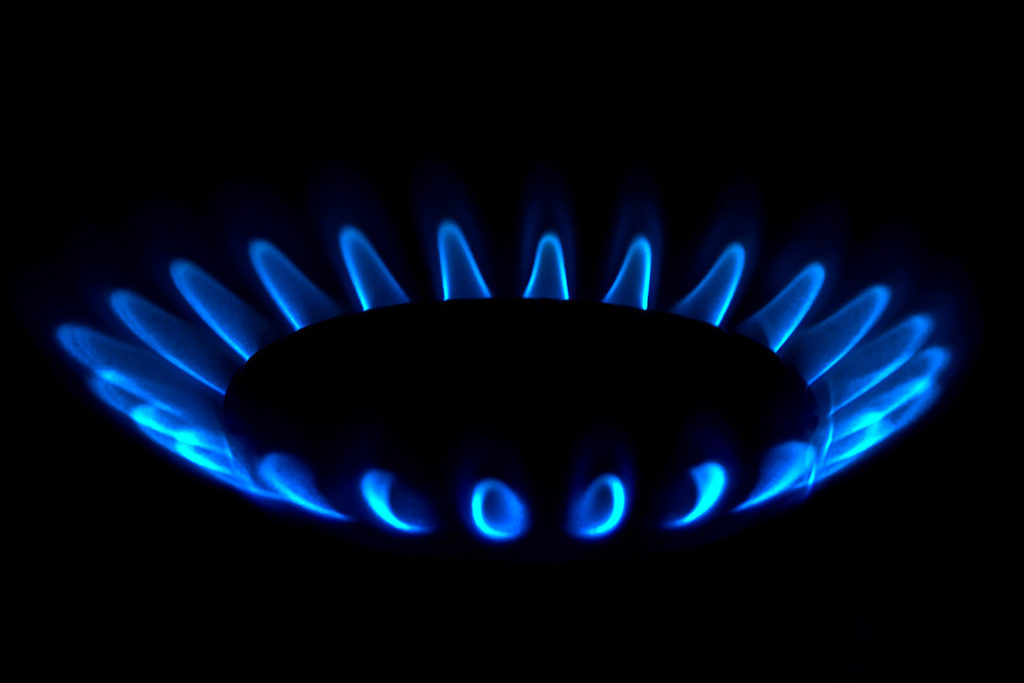
One of the challenges is that when cooking on too thin of a surface you can get hot spots or cold spots. For example a large pan on a small burner needs a thick bottom core to spread the heat evenly. How much heat it retains is related directly to the thickness and type of material it is made from.
For example, I like to sear my steaks on a large cast iron pan because it stays hot even after I throw four steaks on it. It sears them perfectly, better than any other pan. I can’t do that on a carbon steel pan.
On the other hand, carbon steel is light and cools very quickly, which is great for a wok and cooking dishes where I want to move the food around to let it cool off. When I want precise control of the food I’m cooking, carbon steel is a lot of fun to work with.
Since you’re probably going to cook variety of dishes, like me, you’re probably going to need a variety of cookware. Some materials for pots and pans are more versatile, like non-stick, stainless steel, and copper cookware. You can cook a wide variety of stuff on them. They are like the Swiss Army Knife. Stainless steel and copper pans will probably outlive you, if you care for them. So that’s where we’ll start.

Stainless Steel Cookware
Stainless steel cookware has become a go-to tool for the obvious reason. It’s stainless. It won’t discolor or change noticeably no matter what you cook in it.
Stainless steel cookware is durable and can handle whatever you throw at it. It tolerates high heat well and nearly all stainless steel pots and pans are also made with stainless steel handles, without any wooden or plastic components. This also means that they can go straight from the stovetop to the oven, no problem.
Stainless steel cookware is also pretty easy to clean, needing no special treatment to get then sparkling again, though a healthy dose of Barkeeper’s Friend goes a long way in restoring their original mirror-like sheen.

Does Stainless Steel Cookware Need to be Seasoned?
Stainless steel pots and pans do, however, need to be seasoned. They work best when you have seasoned them like you would a cast iron. Also remember to never put cold food in a hot stainless steel pan. If you do, you’re liable to have your food stick to the pan as its cooking.
As long as you remember these stainless steel ground cookware rules, you’ll be able to cook amazing food with stainless steel pots and pans.
Stainless steel’s biggest advantage is it’s lack of reactivity. These are pots and pans built to last, and since they are made of a stainless metal, they’re hardly change on you over time. Stainless steel won’t impart flavors to food, react to acidic food and sauces, or change color on you.
Though it should be remembered that all things considered, steel isn’t actually the greatest metal at conducting heat and on its own doesn’t make for a great cookware material.
That’s exactly why there’s a number of options for stainless steel pots and pans that come with a modifications that make them really shine in the kitchen.
Calphalon Stainless Steel 10-Piece Pots and Pans Set
• Calphalon works great on a gas stove top due to the stainless steel construction
• Thick aluminum base on the bottom of each pot and pan.
• Even heat distribution throughout the pan and up the sides.
• Completely non-toxic, high-quality, stainless steel.
• Tempered glass lids
• Dishwasher safe, making cleanup effortless
• Oven-safe up to 450°F
• Tapered rims to reduce dripping
• Riveted stainless steel handles. One pot includes a helper handles
• Lifetime warranty
Since, as mentioned, stainless steel isn’t the best at conducting heat, most stainless steel cookware will be “clad.”
This simply means that around a core of more conductive metal , there will be a layer of stainless steel. Inside the stainless steel cladding that you see around the exterior of the pan, there will be separate metal core on the inside that the cladding protects and insulates.
This allows you to take advantage of the quick heating and cooling properties of other, usually more reactive, metals, while still having an extremely durable and nonreactive piece of cookware. Basically, the stainless steel acts as a shield for the metal core that’s doing the hard work.
This gives stainless steel cookware a huge range of applications in the kitchen. From searing to frying to simmering sauces, stainless steel is up to it. What you might not be willing to put another pan through, stainless steel cookware will handle easily.
Here’s a very decent Cuisinart Stainless Steel Cookware Set, that includes skillets, saucepans with lids, and stock pots for all your cooking needs.
If you’re looking for a more premier stainless steel cookware set, look no further than this All-Clad Stainless Steel cookware set. All-Clad is the best in the business when it comes to clad pans, and their set also includes all the essentials like skillets, saucepans with lids, and even a stockpot with lid. All-Clad is also particularly known for their extremely ergonomic and tight fitting lids.

Copper Clad – Stainless Steel Cookware
The best benefit here, aside from copper’s excellent performance as a heat conductor, is the cost. Copper clad in stainless steel will always be cheaper than all copper pots and pans.
With a copper core, you’ll be able to enjoy some of the best benefits copper, namely it’s incredibly fast heat up and cool down times. These types of pans are still mostly made of stainless steel though, so they won’t quite match the performance of all copper pots and pans. They will still give you a massive edge in the kitchen, though.
Plus, the fact that the it’s a stainless steel clad pan pretty much negates all the upkeep issues that come with copper.
These wonderful All-Clad 5-ply Copper Core frying pans are far from the budget option, but they are also far from doing the same damage to your wallet as an all copper pan. You won’t have to worry about the upkeep of copper, get your cookware for a more affordable price, and still have an excellent cooking experience with tons of control over your end product.
All-Clad Copper Core 5-Ply Bonded 8-Inch Fry Pan
All-Clad Copper Core Pots and Pans Set are the best for gas stoves due to heat distribution from the thick copper core base bonded to the cooking surface.
There’s nothing like the evenness and responsiveness of cooking on a copper core set of pots and pans. These will last a lifetime or two if treated right, but they aren’t cheap.
Oven safe and broiler safe up to 600°F.
Non-Stick Pots & Pans
Let’s talk about he most most popular type of cookware, not necessarily the longest lasting, but certainly the easiest to use: non-stick cookware.
A nonstick pan is exactly what it sounds like, a pan designed to be nonstick while cooking.
There are two main types of non-stick coatings for pots and pans: PTFE and Ceramic. You may know these two coatings by their famous brand names, Teflon and Thermolon, respectively.
The nonstick surface on these pans prevents food from sticking to the pan during the cooking process. It takes a lot of stress off the cook when it comes to thinks like seasoning the pan.
With nonstick pans, you won’t have to worry about seasoning the pan, having enough oil in the pan, or putting cold food into it. You’ll totally avoid the issue of food sticking to the pan while you’re cooking, especially with delicate proteins like eggs and fish which have a high tendency to stick.
GreenPan Swift Healthy Ceramic Nonstick, 12 Piece Cookware Pots and Pans Set
• GreenPan uses a ceramic non-stick coating called Thermolon.
• Free of toxic chemicals like PFAS, PFOA, lead and cadmium.
• These work great on gas stoves, of course.
• It is oven & broiler safe up to a scorching 600°F!
• The andodized aluminum body is durable and light weight, so it’s easy on the wrists.
• Sweet metal handles are riveted on, which is one marke of quality.
The main draw back is that you’ll have to get the proper utensils for these pots and pans. Stick to silicon, nylon, or wood utensils only, otherwise you might scratch the nonstick surface. Often times these pans will be sold as “scratch-resistant,” and it may be true that they are resistant to scratches, you’ll still need to use the proper utensils.
PTFE pans usually have a stated maximum temperature from the manufacturer of around 500°F.
And if you read the instructions carefully, some manufacturers will recommend that you don’t use their pans near birds.
You might wonder why these are are related. Let me tell you. When PTFE gets too hot, over 550° or so, it starts to emit gasses that toxic to birds. The PTFE non-stick surface is probably breaking down.
So if you have PTFE or Teflon coated pans, remember to keep them from getting too hot. Which is probably a good idea for most cooking, as there is a growing body of information that marks 300°F as the max healthy cooking temp.
All good things come to an end eventually, and so do nonstick pans. They simply won’t last a lifetime. The constant heating and cooling plus the inevitable bumps and scrapes during storage will inevitably degrade the nonstick coating and make it time to go out and get a replacement. You can make them last longer using utensils made of softer materials like silicon, nylon, or even wood, that won’t scratch the coating.
Good news is that nonstick coatings come available on a variety of different types of pans. Whether you prefer stainless steel or aluminum, you’ll be able to find something suitable.
Bonus suggestion: If you’re looking for a solid nonstick pan, look no further than the OXO 8 inch Dishwasher Safe Frying Pan.
Aluminum Clad – Stainless Steel Cookware
Aluminum core stainless steel pots and pans, usually branded “3-ply,” like this Cooks Standard 4 Quart Deep Sauté Pan with Lid, is the sometimes-affordable cousin of copper core stainless steel pots and pans. These pans will tend to be on the cheaper side, since both aluminum and stainless steel are on the cheaper side of metals as well, but that can depend on the brand you are going for.
Aluminum gives a better level of heat control than nearly every other metal, except for copper, and is also far less expensive.
No matter what brand you opt for, these pans work in the same way as all other stainless steel clad pots and pans. Aluminum is good metal for conducting heat, so having it in the core gives you a piece of cookware with more heat control than just plain old steel. The cladding protects the core from being exposed to the elements and protects it from any physical damage or chemical changes.
Copper Pots and Pans
Copper is the “Super Car” of cookware, with performance and price to match.
The warm glow of spotless copper pots and pans hanging in the kitchen conjures up thoughts of tall toques, crisp chef’s coats, marble countertops, names like Escoffier and Ducasse, and perhaps an animated rat with a penchant for Provençal vegetable dishes. Nothing says elegance and class like a set of copper cookware.
But copper pots and pans aren’t just for admiring from a distance and basking in the inviting glow of. They do real work in the kitchen and have been used by generations of top-tier chefs for a reason.
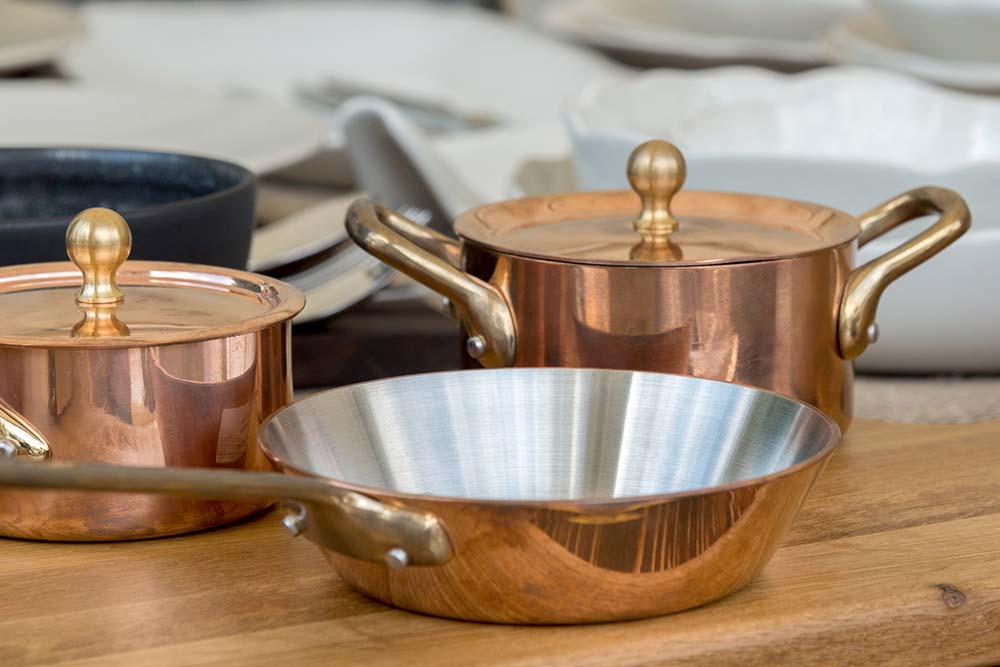
Pros and Cons of Copper Cookware
Like aluminum, copper reacts extremely well to temperature changes. It heats up quick and cools down fast, which gives you excellent heat control while cooking. There really is no better metal in the cookware world in this regard.
Copper pots and pans are the undisputed king of heat conductivity and for that reason are commonly used in high end French kitchens. When it comes to thickening egg yolks without scrambling them or simmering a stock a half-degree below boiling, no other cookware offers a comparable level of control, save maybe aluminum.
The main issue with aluminum is simply that it just doesn’t have the lifespan of copper, to say nothing of the aesthetic. Copper also overtakes aluminum by a substantial margin in the heat conductivity department. Aluminum is above-average, copper is fantastic and without comparison.
As you will immediately notice when you pick one up, copper pots and pans are significantly heavier than aluminum. They take some real muscle to lift and maneuver. This is perhaps the only realm in which aluminum is clearly better than copper.
That being said, copper does suffer from some of the same reactivity issues as aluminum. It’s far from stainless. Like aluminum, acidic food will cause discoloration in copper pots and pans.
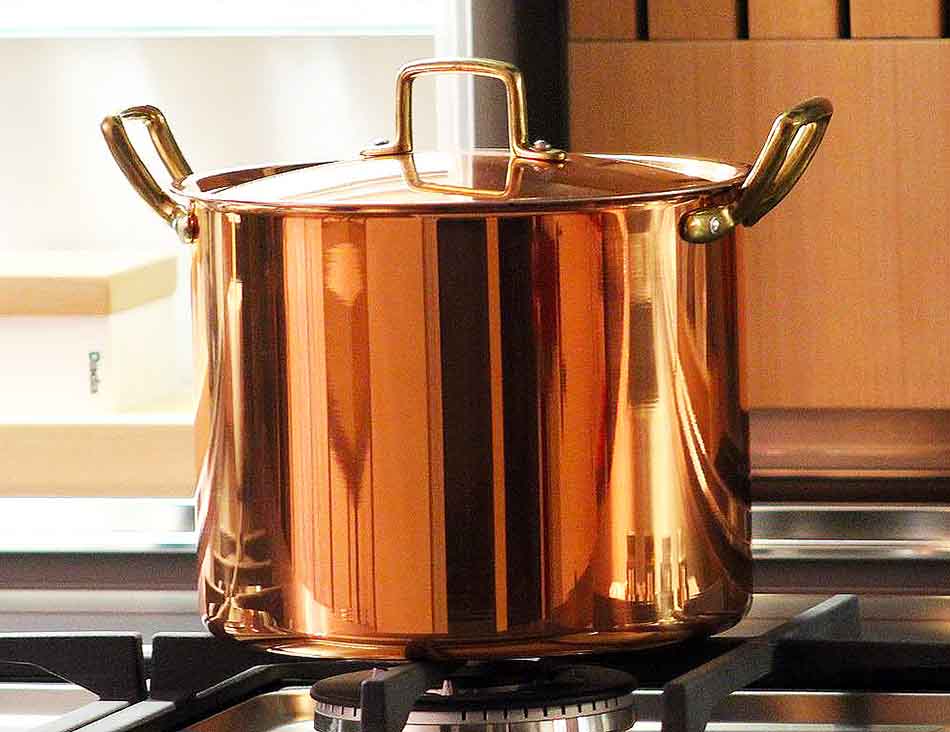
While your copper pan is unlikely to acquire a vibrant sea green patina like the Stature of Liberty through use in the kitchen, you can expect discoloration to occur fairly rapidly.
Even the oils from your hands on the outside of copper pots and pans will nearly instantaneously leave smudges. Depending on your perspective, this is either one of coppers main charms or drawbacks. Some cooks and chefs like kitchen tools that change through use, for others there is no bigger thorn in their side.
Since the chief issue with copper is its reactivity, you’ll find that most copper cookware is lined on the inside. These days you’re liable to see stainless steel, but traditionally tin has been used. You’ll see the same kind of linings in copper flasks or Moscow Mule mugs as with the pots and pans.
Tin is not a very reactive metal, and for this reason is used as a lining. Tin is also pretty bad at conducting heat, though, which is why you don’t see pots and pans made purely of tin.

Copper Cookware Maintenance
In many French kitchens, there’s a yearly ritual sending out all the pots and pans to be re-tinned. As a home cook, you probably won’t have to be worried about this, though. You can easily expect your tin lined copper pots and pans to last not just a lifetime, but generations.
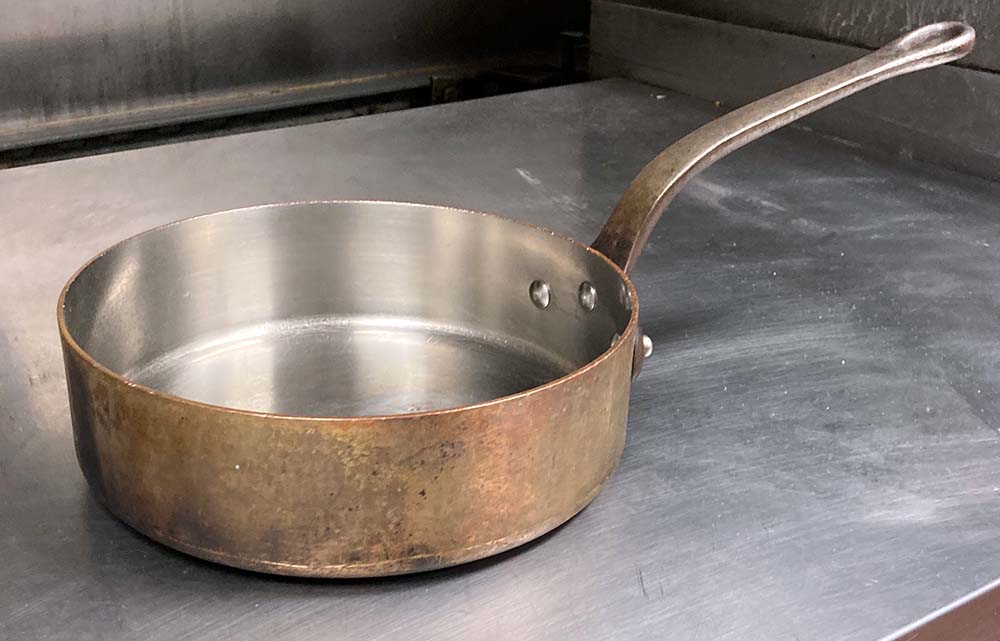
When buying copper pots and pans, look out for the cheaper pans that have the copper color only on the inside. These are copper lined, and won’t provide you with all the wonderful benefits copper provides. You’ll want to specifically look for the pots and pans which have copper all along the exterior, even though they are significantly more expensive.
They don’t come cheap, but these 18/10 stainless steel lined Mauviel Pans are top of the line craftsmanship that are the results of decades, if not centuries, of metalworking experience. You won’t be disappointed with any of Mauviel’s products, and they even sell 9 piece cookware sets if you’re looking to go really big with your purchase.
There’s really no better option when it comes to pots and pans, but be prepared to put up the big bucks to enjoy all the benefits copper offers.
If you’re looking for something that still packs a punch at a slightly lower price point, remember to take a peek at stainless steel copper core pots and pans.
Cast Iron Pots & Pans
Good old cast iron. What started as cheap cookware for pioneers turned into a modern craze, and by now we nearly all have at least one cast iron pan in our kitchen.
It’s already common knowledge that cast iron pots and pans need to be seasoned before use. This prevents both food from sticking and rust from developing.
And again, as you probably know, cast iron needs to be cleaned in a particular way. Never put it in the dishwasher, lest it sit in a soggy environment too long and rust or loose its seasoning to degreaser. Always hand wash cast iron pots and pans, no exceptions.

Cast iron cookware is also quite thick. This means that while it has stellar heat retention and holds heat for a long time, it also takes a long time to get hot. This makes it ideal for searing.
In fact, in most commercial kitchens the only purpose cast iron pans find is searing steaks and scallops, and for this they are incomparable and without competition. They’re the best option for these uses.
Just go with a classic Lodge 12 inch Cast Iron Skillet. Lodge is still the best and most affordable cast pot and pan manufacturer out there. They also have plenty of other products to chose from, including multiple piece cookware sets.
Aluminum Pots & Pans
We’re going to start off our list with aluminum for a number of reasons. Aluminum pots and pans are cheap, easy to find at most stores and online, sturdy enough, and comes with a few unique benefits that are notable for its price point.
Aluminum is a relatively light metal, which is part of the reason it’s so common in airplane construction, and this is probably it’s most immediately detectable upside. Any aluminum cookware is going to be noticeably lighter than stainless steel, and much lighter than cast iron and copper.
Cost of Aluminum Cookware
Aluminum is also very cheap, the cheapest option on our list. You can get a very serviceable and affordable 10-inch skillet. In fact, these types of skillets are the go-to for most restaurants. Chances are, if you peek into a commercial kitchen you’ll see the cooks swinging exactly these pans over the gas burners as they prepare your meal.
That being said, part of the reason restaurants buy these pans is because they also expect to replace them at some point and would rather go with the cheaper option. Aluminum won’t last a lifetime. It scratches and dents pretty easily, and doesn’t tolerate the roughest of treatments.
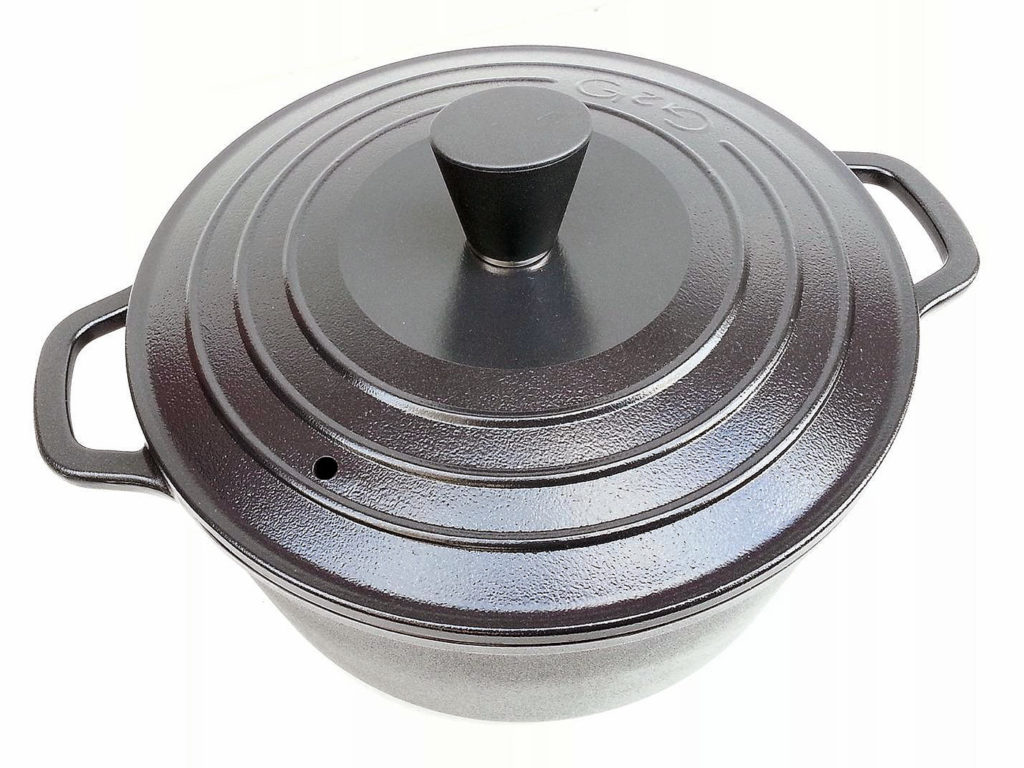
Aluminum Cookware Pros & Cons
Aluminum also has one huge benefit, and that’s its extremely good heat conductivity. But there’s a trade off here, because it also has a huge drawback. It’s also a highly reactive metal, more on this in a bit.
Aluminum conducts heat extremely well. Aluminum pots and pans are second only in cookware materials to copper, which is a good deal more expensive. This means that aluminum will heat up very quickly on the stove and that when you take it off the heat, it will also cool down rapidly.
This significantly reduces downtime while you wait for your pan to get hot. You’ll be ready to go nearly right away.
And since it also cools down quickly, you’ll also have excellent heat control while you cook. If something is getting too hot or is about to burn simply take it off the heat and the temperature will quickly drop.
Keep in mind that this also makes aluminum a poor choice for searing. Since it isn’t that great at retaining heat due to its high heat conductivity, it won’t maintain it’s temperature well when you place a large steak or the like in a pan. For searing, it’s better to go with materials that aren’t quite as conductive, like cast iron or stainless steel.
This brings us back to the main drawback. Aluminum is a highly reactive metal and will change in appearance quite rapidly. A new aluminum pan may be as shiny and reflective as an un-crumpled aluminum foil when you first get it, but within a few uses you’ll notice that it’ll turn gray and tarnished.
Aluminum also tends to react with acidic foods, especially when new. This potentially lead to black marks on the aluminum and in some cases to a metallic taste in the food.

Does Aluminum Cookware Need to be Seasoned?
This raises the question of seasoning. Do you season aluminum pans to create a nonstick and nonreactive coating on the inside of the pan? Not really.
Since aluminum is a good heat conductor, it’s not great for searing since it will lose heat relatively quickly when you place big hunks of meat in it and not be able to sear them well. This restricts their uses primarily to sautéing for pans and regular stocks and soups for pots.
Some websites will recommend that you season aluminum pans, but in professional kitchens this is rarely done. Since aluminum pans are primarily used for sautéing, as mentioned, you’ll generally have enough oil in the pan from the get go to avoid any sticking. Just remember to get the oil in the pan hot before you place food into it.
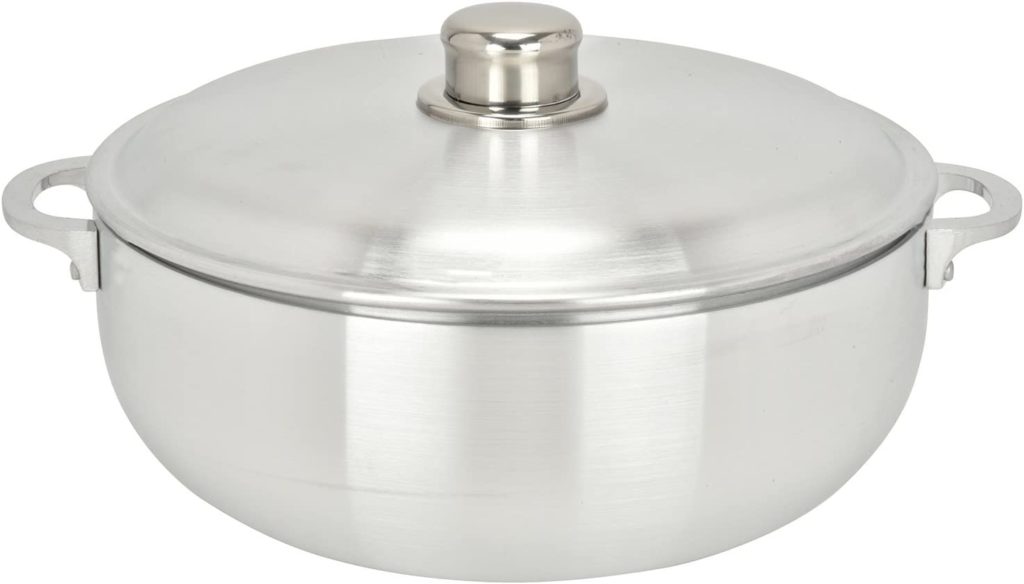
If you’re using a aluminum baking tin or tray, just follow the instructions in the recipe. They’ll usually mention whether its necessary to either spray the cookware with oil, rub with butter, or line with parchment paper.
Some studies in the past indicated that aluminum is not necessarily safe to cook with, but today we know that it is pretty much totally safe and non-toxic.
Luckily, the tarnish or patina on aluminum cookware is a good thing. By causing the surface of the pan to oxidize, over time you will have made a less reactive metal surface. This makes it less likely to impart metallic flavors, because the surface of the pan or pot has already reacted and become “passive,” in scientific terms.
Remember though, since aluminum is a non-ferrous metal, it won’t work with induction cooktops. Besides that though, they will work equally well with both gas and electric stoves. They’re an excellent choice for the home cook on a strict budget.
Hard-Anodized Aluminum Cookware
If you want to skip the whole reactive metal issue, you can go with hard-anodized cookware.
The term “anodized” refers to the fact that the aluminum has been immersed into a chemical bath through which electric currents have been passed. This is a process of controlled oxidization that causes the surface of the metal to react and become hardened and less reactive. When this has been done for an extended period of time you get “hard-anodized” aluminum.
Calphalon 10-Piece Pots and Pans Set
Hard-anodized aluminum cookware is very durable and naturally resists corrosion, so they last.
The long silicone handles are great and are oven safe up to 400°F too, but much cooler to the touch than stainless steel alone.
This set comes with 2 layers of nonstick so you can cook those eggs perfectly while also having an easy cleanup. PFAS free.
Basically, the end result is a fully oxidized aluminum pan that is far less likely to react with any food or acidic ingredients and is slightly nonstick.
This is a great option if you’re not a fan of cookware that changes as use you use it, but it runs slightly more expensive than regular aluminum.

Here’s a great All-Clad Hard Anodized Cookware Set if you think material seems right up your alley. Often, these pans will be fully hard anodized nonstick cookware. Many companies sell full Hard Anodized nonstick cookware sets, so feel free to look up your favorite brand and stock your kitchen with their pots and pans.
Enameled Cast Iron
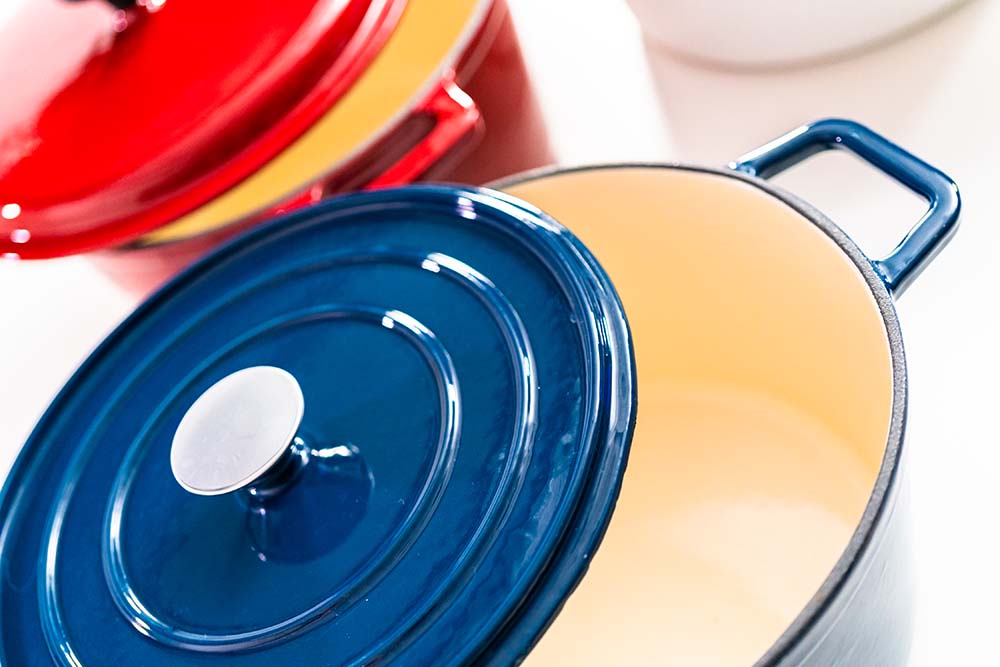
If you’re looking for colors outside of dour and rustic black, enameled cast iron cookware might be the choice for you.
Enameled cast iron cookware comes in a veritable rainbow of options, and some brands like Le Creuset have a particular focus on color options.
It’s not just aesthetics though, enamel is nearly completely nonreactive. Enameled cast iron will never rust, and in general requires less upkeep than regular cast iron, if at a higher cost.
However, enamel is not particularly good at conducting heat. So you are more likely to find enameled pots than pans, like a dutch oven. In general, these enameled cast iron pots will be geared towards slow cooking.
Enameled cookware is also traditionally used in certain “white” sauce or stew recipes, like Blanquette de veau. In these white stews, you’re looking for as little caramelization as possible so that you can preserve the creamy white color of the meat and sauce. Enameled pots distribute heat more evenly than regular cast irons because of their totally smooth interiors and also make it easier to spot bits of early caramelization beginning to occur against their lighter colored enamel coatings.
Though, hey, you may just be looking for a statement piece.
Carbon Steel Pots & Pans
Carbon steel is not the most common type of cookware material you’ll come across these days, but it has a long history. Though it’s not super common to find carbon steel pots and pans in general these days, for certain types of pans like woks there’s still a wide selection available.

These pans pans tend to be very thin, and quite light. This makes it so that while steel as a metal isn’t very good at conducting heat, the thinness of a carbon steel pan allows the pan to heat up and cool extremely rapidly.
You can easily use carbon steel pots and pans with gas or electric stoves or even induction cooking surfaces.
Carbon steel is a very reactive metal. Except to see discoloration occur fairly rapidly, even just from the oils in your skin when you touch it, to say nothing of acidic foods. And if you leave it wet for too long, expect to see rust.
These pans need a touch more upkeep than some of the other options and they will also need to be seasoned before use to prevent food from sticking to them.
They are rather affordable, though, and do offer a fairly high degree of heat control while cooking because of their thinness.
You’ll also notice that carbon steel pots and pans are often labeled either blue or black steel. This simply refers to the finish the manufacturer gave it to help protect against rust and corrosion. Over time, all your carbon steel pans will darken or patina, one way or another.

This color change or patina is a good thing. It just means that the surface of the pan is reacting, and is becoming less susceptible to corrosive elements.
In many ways, you can think of these pans as an alternative to cast iron. It requires the same time of care and maintenance, but gives you some bonuses through its thinness. These pots and pans will be lighter and heat up faster, though they won’t retain heat for quite as long.
The Merten & Stock 8 inch Frying Pan is a good place to start if you’re interested in carbon steel, and at it’s price point you don’t need to be too worried about ruining it.
If you’re looking for an absolute classic of a wok, this craft 14-inch wok is a great option. Many Asian chefs swear by carbon steel woks in particular.
You’ll also find that many paella pans will be made out of carbon steel.

